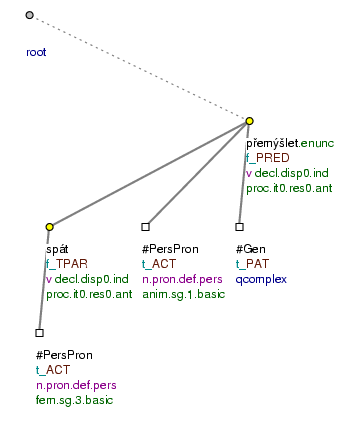- Definition of the
TPARfunctor -
The
TPARfunctor (temporal parallel, contemporaneous) is a functor for a free modification that expresses specification of time answering the question "during what time?", or "simultaneously with what?".
A modification with the TPAR functor expresses the temporal extent of the event or state of the governing word either by direct specification of the time/duration (během pěti hodin (=during five hours), po celou hodinu (=during the whole hour)), or by specifying the temporal relation to another event; in such case it expresses simultaneity of two events (během snídaně (=during the breakfast), souběžně s přednáškou (=simultaneously with the lecture)).
Forms. The basic forms of TPAR modifications are:
-
prepositional phrase.
The most common forms:
během+2 Během naší dovolené ani jednou nepršelo. (=lit. During our holiday not once (it) rained.) o+6 Turisté zamířili o dovolené do Švýcarska. (=lit. Turists went on holiday to Switzerland.) po+4 Po celou dobu mě nepřestala bolet hlava. (=lit. For all (the) time - has_not_stopped aching (my) head.) průběhem+2 Průběhem času nastaly změny. (=lit. (With) (the) course (of) time came changes.) přes+4 Přes celé léto se tam nedostal. (=lit. During (the) whole summer (he) - there did_not_get.) při+6 Při jízdě do lodi trochu nateče. (=lit. When floating into (the) boat a_little (of)_water gets.) souběžně s+7 Souběžně s přednáškou probíhaly semináře. (=lit. Simultaneously with (the) lecture were_runnig seminars.) současně s+7 Současně s přednáškou probíhaly semináře. (=lit. Simultaneously with (the) lecture were_runnig seminars.) v průběhu+2 Dělo se to v průběhu cesty. (=lit. Was_happening - it - during (the) journey.) za+4 Za celou hodinu přišli jen tři lidé. (=lit. During (the) whole hour came only three people.) za+2 Za deště nezpívají ptáci. (=lit. In (the) rain do_not_sing birds.) zároveň s+7 Zároveň s překladem píšou recenzi. (=lit. Simultaneously with (the) translation (they) have_been_writing (a) review.) -
noun in a non-prepositional case.
The most common forms:
instrumental Cestou do Norimberku jsme třikrát stavěli.(=On the way to Norimberk we stopped three times.) -
adverbial expressions.
Examples:
Hraje a přitom.
TPARzpívá. (=lit. (He) is_playing and at_the_same_time singing.)Mezitím.
TPARsi připravoval oběd. (=lit. Meanwhile (he) (for) himself was_making lunch.)Zamlada.
TPARbyl neustále veselý. (=lit. When_young (he) was always cheerful.)Zároveň.
TPARv duchu počítal. (=lit. At_the_same_time to_himself (he) counted.)Zatím.
TPARmůžete odpočívat. (=lit. Meanwhile (you) can rest.) -
dependent clause.
The most common forms:
zatímco Zatímco Sára ještě spí, zapřáhne osla. (=lit. While Sarah still is_asleep, (he) yokes (a) donkey.) mezitím - co Mezitím, co se novináři dobývali na hráče, trenéři odpovídali na tiskové konferenci. (=lit. While - journalists were_trying_to_reach (the) players, coaches were_giving (a) press conference.) Example:
Zatímco spala.
TPAR, přemýšlel jsem.(=lit. While (she) was_sleeping (I) was_thinking.) Fig. 7.16
Agreeing form of an adjective. With nouns referring to events (nouns ending with -ní and tí; see Section 2.4.3.3, "Functors assigned to the non-valency modifications of nouns referring to events"), TPAR modifications can also be expressed by an agreeing forms of adjectives (but this is rare).
Example:
současné.TPAR zrušení clearingového zúčtování a dovozní přirážky (=lit. simultaneous cancellation (of) clearing account and import surcharge)
Figure 7.16. The TPAR functor

Zatímco spala, přemýšlel jsem. (=lit. While (she) was_sleeping (I) was_thinking -.)
Borders with other temporal functors. Many prepositions, esp. secondary prepositions, unambiguously express the TPAR meaning (současně_s (=simultaneously_with), během (=during)); however, with primary prepositions, the situation might be less straightforward as they are often ambiguous. Cf.:
-
Napsal to za dvě hodiny.
THL(=lit. (He) wrote it in two hours.) -
Za dvě hodiny.
TPARnic neudělal. (=lit. For two hours (he) anything has_not_done.)
A similar situation may arise with adverbs. Cf.:
-
Zamlada.
TPARbyl neustále veselý. (=lit. When_young (he) was always cheerful.) -
Napsal to ještě zamlada.
TWHEN. (=lit. (He) wrote it still when_young.)
Border with the ACMP functor. The TPAR functor is close both in its semantics and its form to the ACMP functor (see Section 6.1, "ACMP"), esp. in its meaning "simultaneously with what? ". Whenever the prepositional phrase cannot be clearly interpreted as a temporal modification (two parallel events), the prepositional phrase is assigned the ACMP functor (accompaniment). Cf.:
-
Souběžně s přednáškou.
TPARprobíhaly i semináře. (=lit. Simultaneously with (the) lecture were_running seminars.) -
Souběžně s hřebíky.
ACMPvyráběli i matky. (=lit. Simultaneously with nails (they) produced also nuts.)
Border with the CONTRD functor. The conjunction zatímco (=while) can introduce not only a dependent clause with the meaning of the TPAR functor, but also a dependent clause with the meaning of the CONTRD functor (see Section 9.2, "CONTRD"). For details see Section 9.2.1, "Borderline cases with the functor CONTRD".